Utilization of PP Plastic Waste for Fuel Oil Production through Pyrolysis Process with Rice Husk Briquette Burning Gasification †
Abstract
1. Introduction
1.1. Literature Review
1.2. Sensible Heat
1.3. Latent Heat
1.4. Heat Energy Input
1.5. Thermal Efficiency
2. Research Methodology
3. Results and Discussion
3.1. Average Combustion Temperature of Rice Husk Briquette Gasification Using the Stove Six Times
3.2. Average Temperature in the Distillation Reactor Section
3.3. Total Mass of Fuel Produced from the Pyrolysis Process
3.4. Water Boiling Test Result
4. Conclusions
Author Contributions
Funding
Institutional Review Board Statement
Informed Consent Statement
Data Availability Statement
Acknowledgments
Conflicts of Interest
References
- Baharudin, H.; Windarta, J.; Giovanni, E.H. Konversi Limbah Plastik Menjadi Bahan Bakar. J. Energi Baru Dan Terbarukan 2020, 1, 1–6. [Google Scholar] [CrossRef]
- Landi, T.; Arijanto, A. Perancangan Dan Uji Alat Pengolah Sampah Plastik Jenis Ldpe (Low Density Polyethylene) Menjadi Bahan Bakar Alternatif. J. Tek. Mesin Undip. 2017, 5, 1–8. [Google Scholar]
- Nasrun, N.; Kurniawan, E.; Sari, I. Pengolahan Limbah Kantong Plastik Jenis Kresek Menjadi Bahan Bakar Menggunakan Proses Pirolisis. J. Energi Elektr. 2017, 4, 1–5. [Google Scholar] [CrossRef]
- Sharuddin, S.D.; Abnisa, F.; Daud, W.M.; Aroua, M.K. Pyrolysis of plastic waste for liquid fuel production as prospective energy resource. In IOP Conference Series: Materials Science and Engineering; IOP Publishing: Bristol, UK, 2018; Volume 334. [Google Scholar] [CrossRef]
- Nasution, A.Y. Analisis Kalor Pada Alat Pengolah Sampah Plastik Dengan Metode Pyrolisis Dengan Perbandingan Tipe Sampah Plastik. Suara Tek. J. Ilm. 2020, 11, 25. [Google Scholar] [CrossRef]
- Raja, A.; Murali, A. Conversion of Plastic Wastes into Fuels. J. Mater. Sci. Eng. B 2011, 1, 8689. [Google Scholar]
- Pujotomo, I. Potensi Pemanfaatan Biomassa Sekam Padi Untuk Pembangkit Listrik Melalui Teknologi Gasifikasi. Energi Kelistrikan 2018, 9, 126–135. [Google Scholar] [CrossRef]
- Dhanak, D.V.; Patel, V.R. Biomass Gasification: A Modern Approach for Renewable Energy Utilization. GRD J.-Glob. Res. Dev. J. Eng. 2016, 1, 58–65. Available online: www.grdjournals.com (accessed on 5 March 2024).
- Subroto; Wijianto; Sarjit; Himawanto, D.A. Continuous and uncontinuous gasification systems of rice husk using variation modification of burner. In IOP Conference Series: Materials Science and Engineering; IOP Publishing: Bristol, UK, 2018; Volume 403. [Google Scholar] [CrossRef]
- Suprianto, F.D.; Gotama, G.J.; Evander, J.; Kasrun, A. Investigation on biomass briquette from Cerbera manghas waste twigs as renewable energy source. ARPN J. Eng. Appl. Sci. 2018, 13, 1080–1084. [Google Scholar]
- Surono, U.B. Berbagai Metode Konversi Sampah Plastik Menjadi Bahan Bakar Minyak. J. Tek. 2013, 3, 31. [Google Scholar]
- Ridhuan, K.; Irawan, D. Buku Energi Terbarukan Pirolisis; CV. Laduny Alifatama: Metro, Indonesia, 2020. [Google Scholar]
- Belonio, A.T. Rice Husk Gas Stove Handbook. Bioenergylists.Org. 2005, p. 155. Available online: http://bioenergylists.org/stovesdoc/Belonio/Belonio_gasifier.pdf (accessed on 5 March 2024).
- Adoe, D.G.; Bunganaen, W.; Krisnawi, I.F.; Soekwanto, F.A. Pirolisis Sampah Plastik PP (Polyprophylene) menjadi Minyak Pirolisis sebagai Bahan Bakar Primer. LONTAR J. Tek. Mesin Undana 2016, 3, 17–26. [Google Scholar]
- Wahyudi, J.; Prayitno, H.T.; Astuti, A.D. Pemanfaatan Limbah Plastik Sebagai Bahan Baku Pembuatan Bahan Bakar Alternatif. J. Litbang 2018, 14, 58–67. [Google Scholar] [CrossRef]
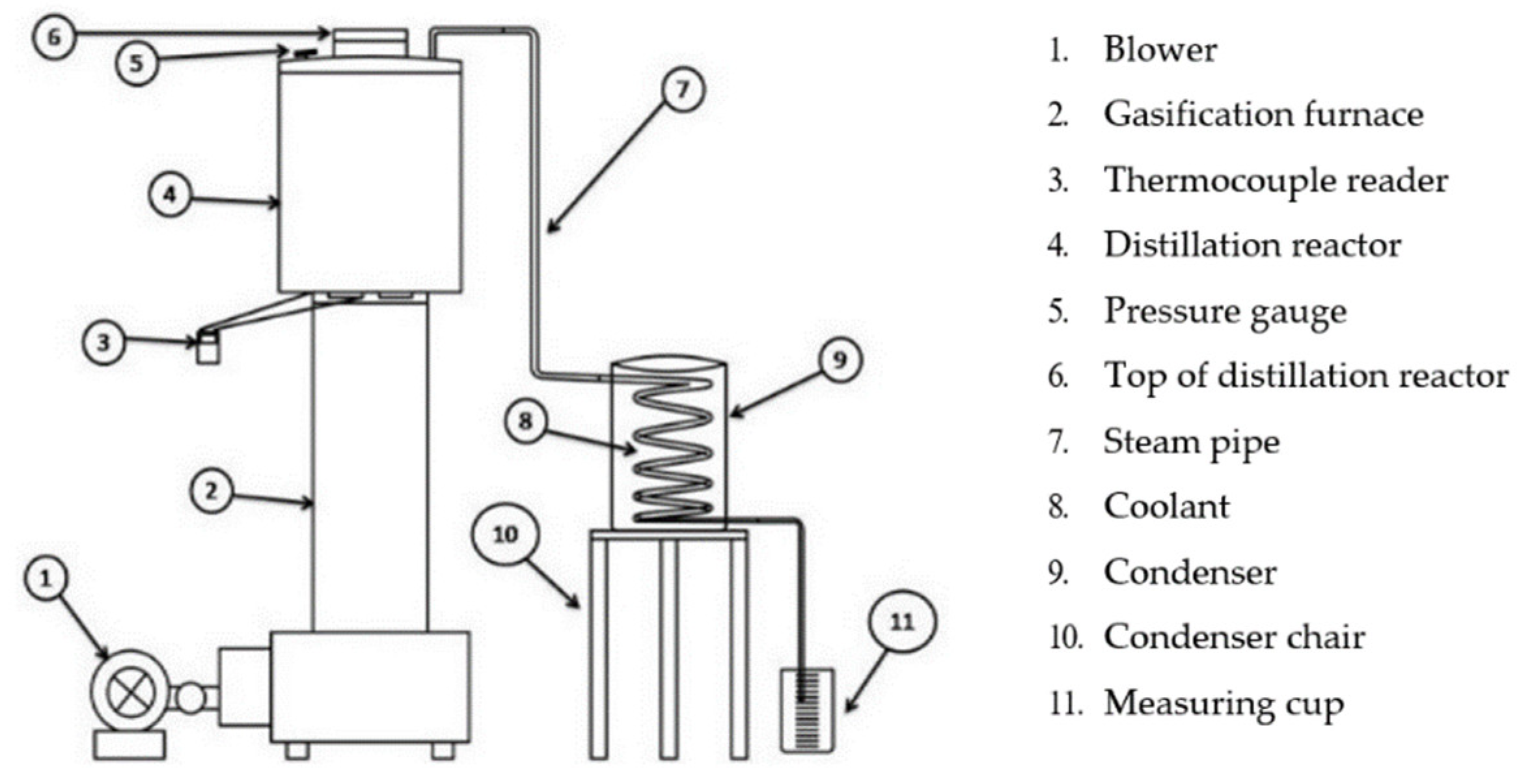
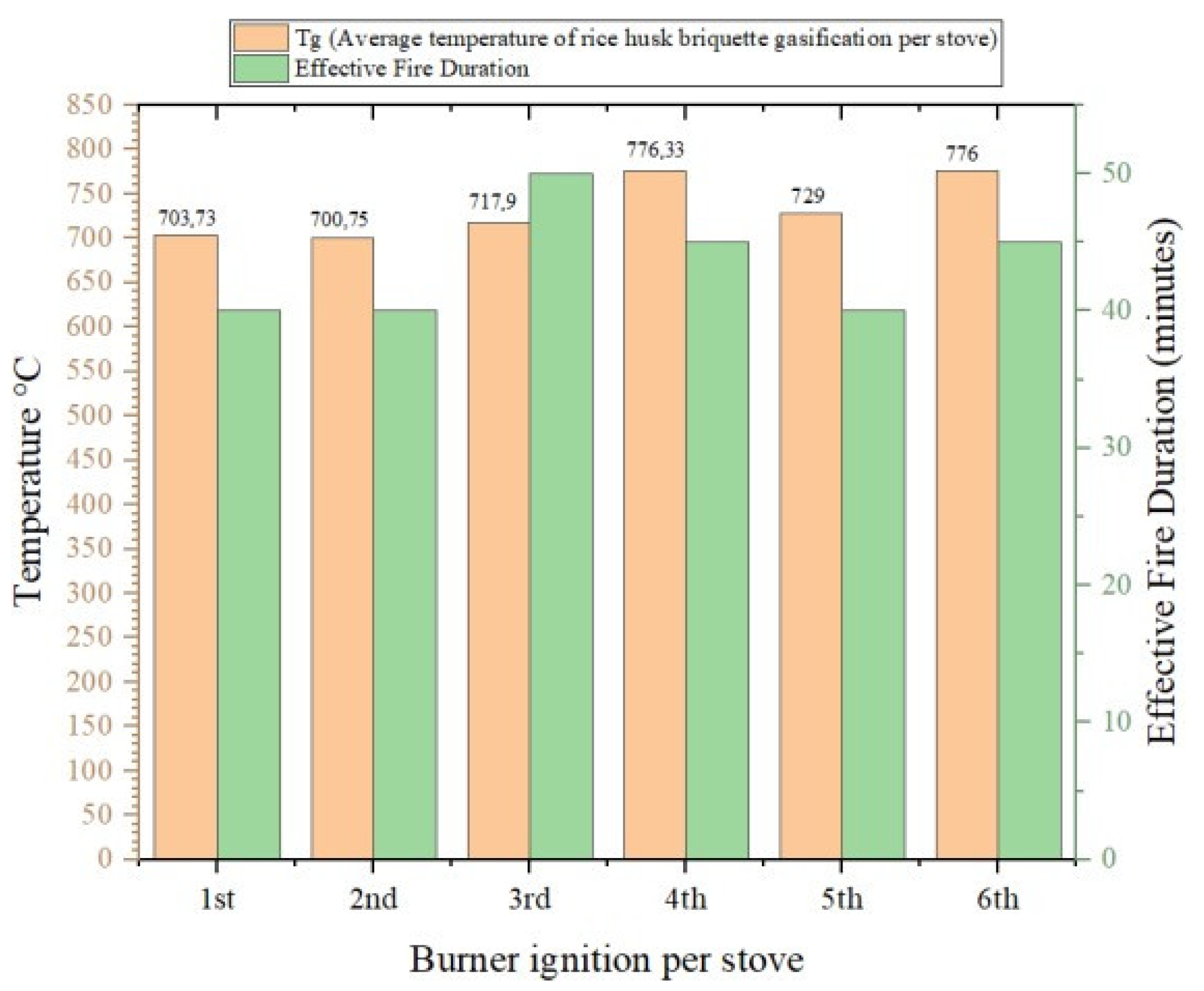
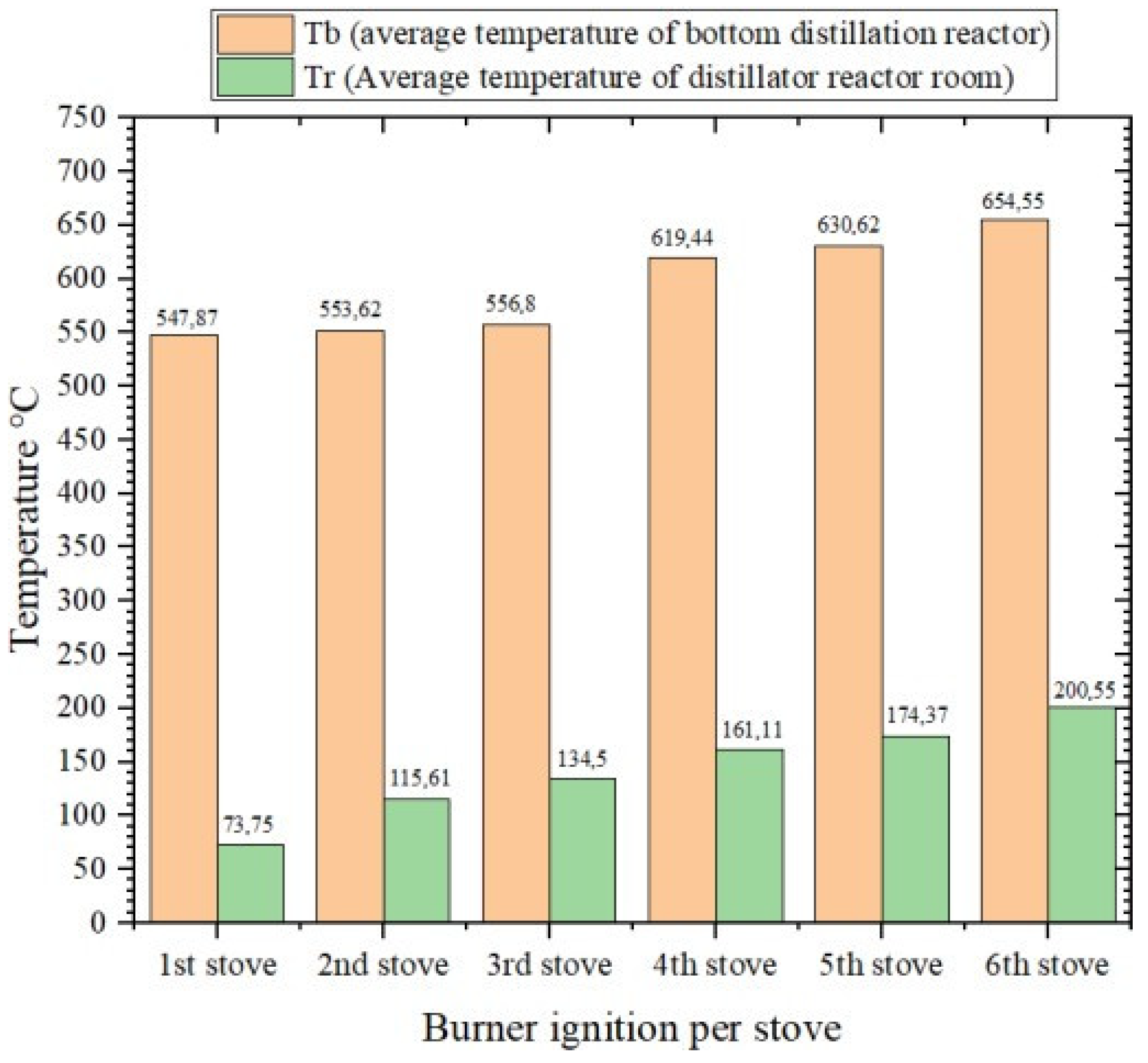
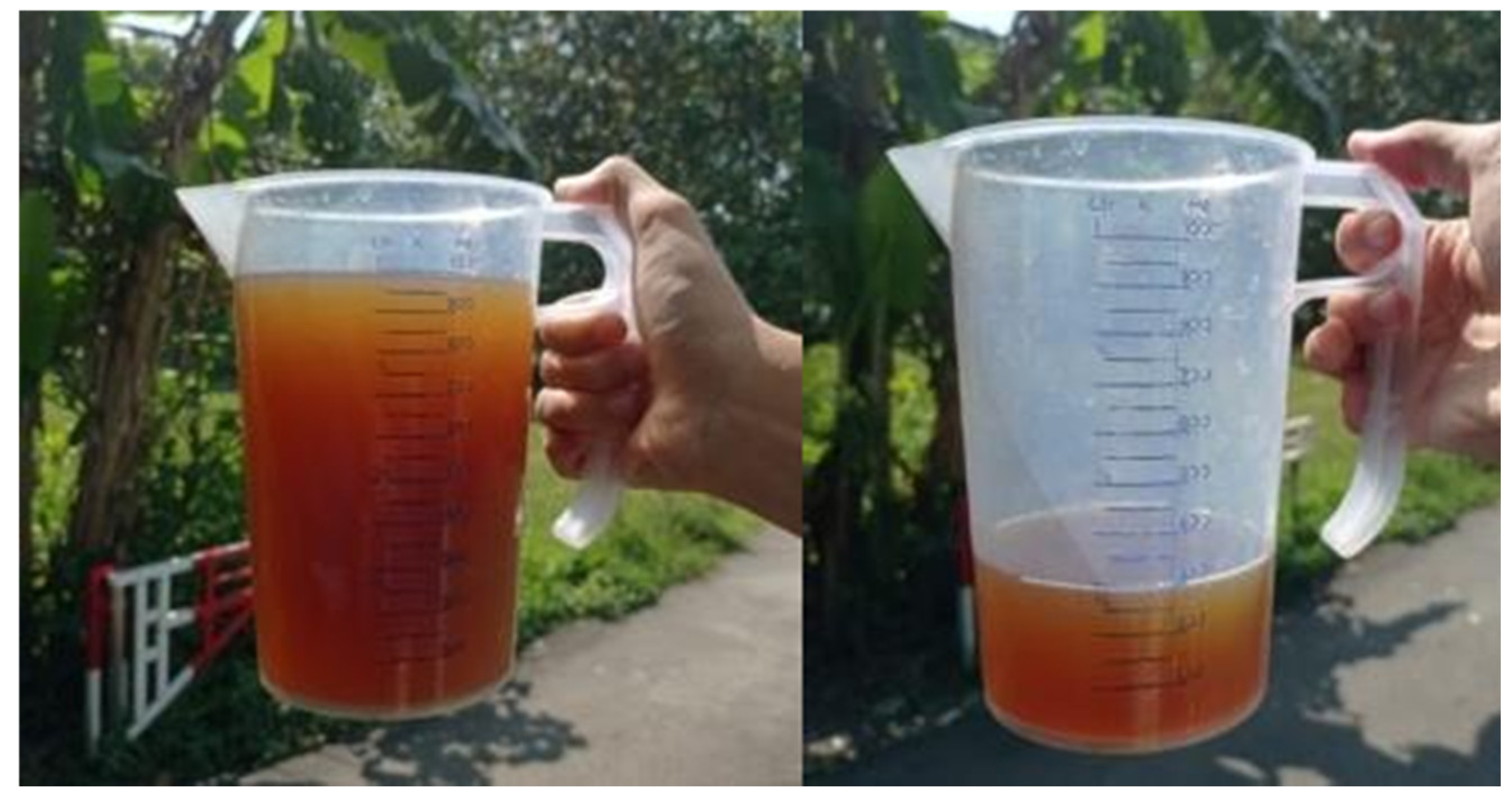
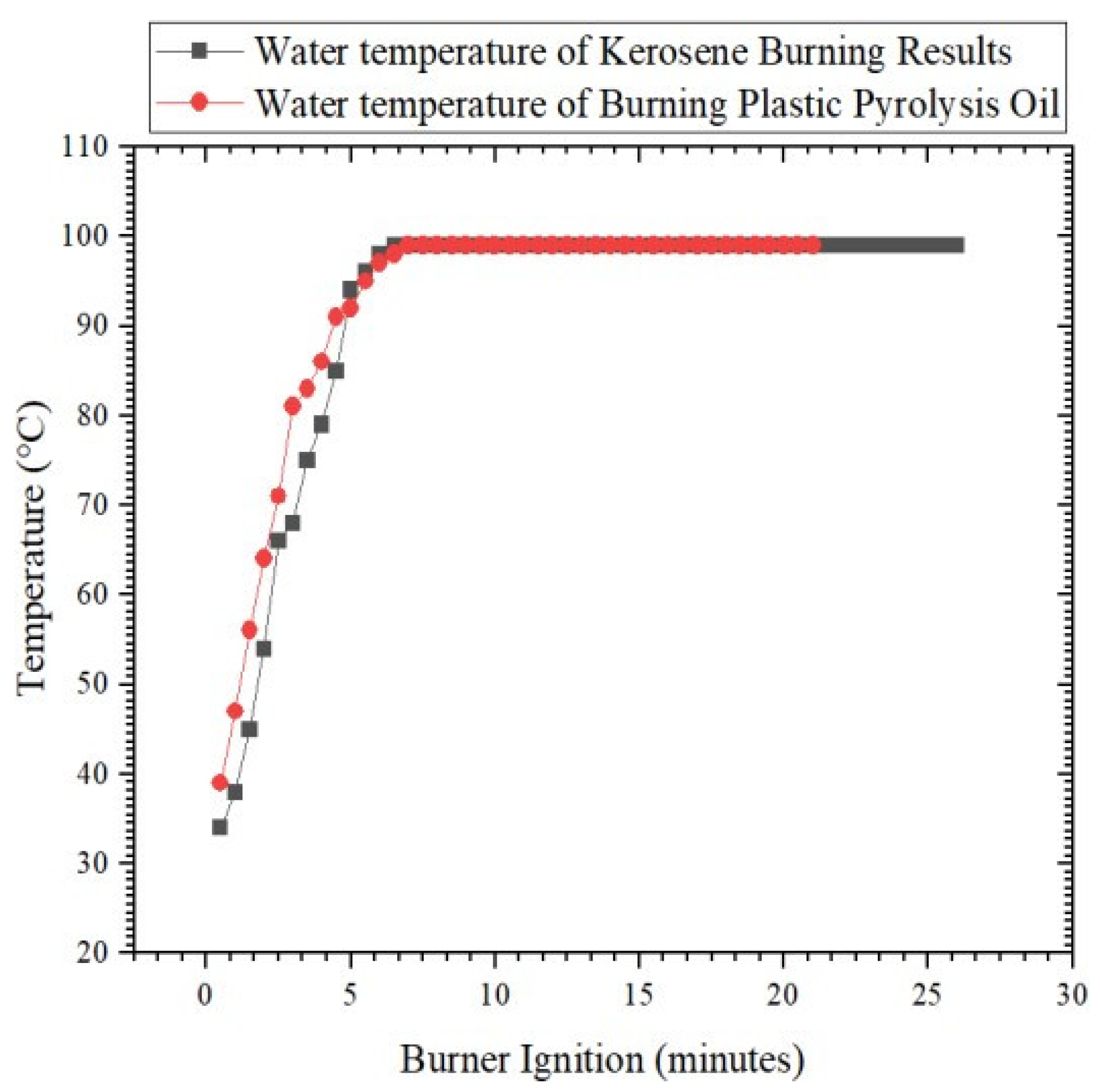
| Code No. | Plastic Type | Use |
|---|---|---|
| 1 | PET (polyethylene terephthalate) | bottled mineral water bottles, and oil bottles |
| 2 | HDPE (high-density polyethylene) | medicine bottles, liquid milk bottles, lubricating jerry cans, and cosmetic bottles |
| 3 | PVC (polyvinyl chloride) | water hoses, building pipes, toys, plastic tablecloths, shampoo bottles, and chili bottles |
| 4 | LDPE (low-density polyethylene | plastic bags, plastic caps, frozen meat plastic wrap, and various other thin plastics. |
| 5 | PP (polypropylene or polypropene) | plastic cups, plastic bottle caps, children’s toys, and margarine |
| 6 | PS (polystyrene) | CD boxes, plastic spoons and forks, plastic cups, styrofoam food containers, and transparent plastic containers |
| 7 | Other (O), other plastic types apart from no. 1 to 6 | baby milk bottles, plastic packaging, drinking water containers, auto parts, household goods, computers, electronic devices, toothbrushes, and Lego toys |
| Type of Material | Tm (°C) | Tg (°C) | Max Working Temperature (°C) |
|---|---|---|---|
| PP | 168 | 5 | 80 |
| HDPE | 134 | −110 | 82 |
| LDPE | 330 | −115 | 260 |
| PA | 260 | 50 | 100 |
| PET | 250 | 70 | 100 |
| ABS | 110 | 85 | |
| PS | 90 | 70 | |
| PMMA | 100 | 85 | |
| PC | 150 | 246 | |
| PVC | 90 | 71 |
Disclaimer/Publisher’s Note: The statements, opinions and data contained in all publications are solely those of the individual author(s) and contributor(s) and not of MDPI and/or the editor(s). MDPI and/or the editor(s) disclaim responsibility for any injury to people or property resulting from any ideas, methods, instructions or products referred to in the content. |
© 2024 by the authors. Licensee MDPI, Basel, Switzerland. This article is an open access article distributed under the terms and conditions of the Creative Commons Attribution (CC BY) license (https://creativecommons.org/licenses/by/4.0/).
Share and Cite
Wijianto; Hayatullah, W. Utilization of PP Plastic Waste for Fuel Oil Production through Pyrolysis Process with Rice Husk Briquette Burning Gasification. Eng. Proc. 2024, 63, 22. https://doi.org/10.3390/engproc2024063022
Wijianto, Hayatullah W. Utilization of PP Plastic Waste for Fuel Oil Production through Pyrolysis Process with Rice Husk Briquette Burning Gasification. Engineering Proceedings. 2024; 63(1):22. https://doi.org/10.3390/engproc2024063022
Chicago/Turabian StyleWijianto, and Wahyu Hayatullah. 2024. "Utilization of PP Plastic Waste for Fuel Oil Production through Pyrolysis Process with Rice Husk Briquette Burning Gasification" Engineering Proceedings 63, no. 1: 22. https://doi.org/10.3390/engproc2024063022
APA StyleWijianto, & Hayatullah, W. (2024). Utilization of PP Plastic Waste for Fuel Oil Production through Pyrolysis Process with Rice Husk Briquette Burning Gasification. Engineering Proceedings, 63(1), 22. https://doi.org/10.3390/engproc2024063022





